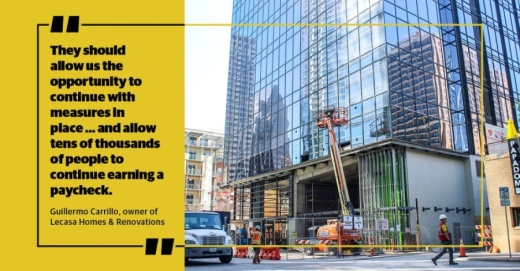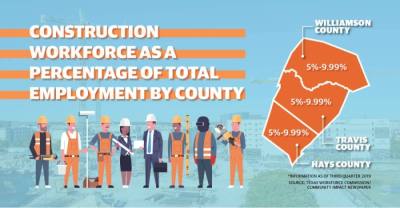Gov. Greg Abbott on March 31 issued an executive order that implements essential services protocols across the state of Texas.
The protocols follow guidelines set by the U.S. Department of Homeland Security. Those guidelines define residential construction “to ensure additional units can be made available to combat the nation’s existing housing supply shortage” as essential work.
Further, work that supports the construction of housing, such as inspection, permitting and plan review, have been deemed essential by these protocols.
Abbott’s March 31 executive order immediately supersedes local orders, such as the city of Austin’s guidelines that effectively banned residential construction sites.
The executive order will become effective at 12:01 a.m., April 2. According to the order, other essential services may be added with the approval of the Texas Division of Emergency Management.
ORIGINAL POST
Homebuilders and real estate groups across the Austin area are ringing alarm bells over the possibility of watching the city's already narrow housing inventory continue to shrink as thousands of construction projects across Austin close down due to the coronavirus.
On March 24, Austin Mayor Steve Adler administered a shelter-in-place order that closed all nonessential businesses. The order included prohibitions on construction sites for residential properties that do not include affordable housing units.
The city of Austin’s Development Services Department on March 30 distributed a document that provided supplemental guidance for the construction industry.
According to the document, the city created an administrative process that will make determinations on whether a construction site can operate during the city’s shelter-in-place order.
This process, dubbed the Construction Exemption Review Committee, includes members from multiple city departments. According to the city of Austin’s website, the committee reviews exemption requests on a daily basis—which can be submitted through a form online—and decisions made by the committee are not subject to appeal.
The new guidance document from the development services department did not amend the city’s current ban on residential construction sites, and some area builders believe those rules are too restrictive.
“The long-term ramifications of this are going to be substantial,” said Guillermo Carillo, owner of Lecasa Homes & Renovations. “I hope the city reconsiders [its] position.”
The city of Austin’s Development Services Department did not provide a comment to Community Impact Newspaper for this article.
Construction hits a red light
According to the Austin Development Services Department, construction can currently continue on public works projects; critical infrastructure; and residential projects, which include affordable housing units, projects that provide facilities for people experiencing homelessness, and projects that are supporting social services or essential businesses.
On the city’s website, acupuncture facilities, alcohol distributors and pool cleaners are, among others, examples of businesses considered essential by the order. According to the city’s guidance, commercial construction supporting these businesses would be permitted to continue.
While shelters are listed under essential businesses, as defined by the city of Austin, most residential construction sites were ordered to shut down in the March 24 stay-in-place order.
“It seems incredulous to believe that beauty supply stores, lawn care, pool cleaners and car washes are permitted, while constructing homes is not,” said Carrie Ciliberto, CEO of the Home Builders Association of Greater Austin, in an email to Community Impact Newspaper.
Across the city, residential construction projects are explicitly allowed to continue if the development contains affordable housing units, according to Austin’s March 24 stay-in-place order.
There are currently 32 residential projects in Austin with affordable housing units that have had building permits issued, according to the city’s Affordable Housing Directory. It is unclear if all of those construction sites are currently active.
Tracking housing inventory
If residential construction site bans continue to hold, the city of Austin’s housing inventory—how much time it would take for every home on the market to sell if no new properties were built—will potentially disappear by the time construction can begin again, local homebuilders say.
“Scheduling is so sensitive in the construction industry because we have to have everyone aligned,” Carillo said. “Let’s say we’re out of business for two weeks. Even in that short period of time everyone is going to get so far behind, and the city of Austin needs that inventory.”
Numbers from the Austin Board of Realtors showed housing inventory was shrinking at a quick pace even before any construction was halted to stop the spread of the coronavirus.
Over the past six months, housing inventory across the city has been cut by almost half. In September, Austin had 1.9 months of housing inventory. By February, that number dropped to just one month of inventory.
The Texas A&M University Real Estate Center considers a real estate market with 6.5 months of inventory to be a balanced market.
Carillo told Community Impact Newspaper that some residents, including himself, were expecting to move into newly constructed or renovated homes in the near future before the order went into effect.
“[Contractors] have clients that are renting an Airbnb—they can’t move into their house. ... It is affecting a number of people throughout the city,” Carillo said.
The order and the supplemental guidance issued March 30 both outlined permissions for a construction site to continue if builders can demonstrate “it is winding down its operations in an efficient and safe manner.”
Ciliberto went further, saying she fears the shutdown will contribute to the city’s ongoing issue with people experiencing homelessness.
“I have heard from a number of builders that many of their clients are living in leaseback situations that will expire and leave them homeless within the next 30 days, exacerbating a serious pre-existing problem,” Ciliberto said in an email. Austin construction ban is restrictive
On March 28, the U.S. Department of Homeland Security issued a letter clarifying the federal government’s position on what is considered critical infrastructure during the coronavirus outbreak. The letter states it is “advisory in nature” and not a federal directive or standard.
According to the DHS letter, development work is considered essential if it is “performing housing construction related activities to ensure additional units can be made available to combat the nation’s existing housing supply shortage.”
Austin is one of the few cities across the country that is currently mandating construction stops on residential projects that do not contain affordable housing, according to the Real Estate Council of Austin.
In a March 27 letter, the real estate council states Austin’s ban is more restrictive than stoppages in Los Angeles, Dallas, San Antonio and even New York, where 932 patients have died from coronavirus, according to Johns Hopkins University.
Currently, the city of Houston is permitting “infrastructure, development, operation and construction,” according to the city’s stay-at-home order.
Just north of Austin, Williamson County is permitting residential and commercial construction to continue.
“We could have issued orders to shut down all construction, and we haven’t done that,” Williamson County Judge Bill Gravell said March 30. “The [Occupational Safety and Health Administration] guidelines are as stringent or more stringent than the guidelines we have for social distancing.”
In Round Rock, construction is ongoing at the $550 million Kalahari Resorts & Conventions site. As previously reported by Community Impact Newspaper, between 700-1,000 workers are on-site at Kalahari daily, according to project general contractor Hensel Phelps.
Representatives from Kalahari have not responded to multiple interview requests. However, per the Williamson County orders, development is expected to continue at the site.
Leander Mayor Troy Hill on March 26 declared local critical infrastructure to include residential and commercial construction.
Labor going elsewhere
Homebuilders and real estate organizations in the Austin area are now concerned the construction labor force will begin to migrate away from the city as job opportunities disappear.
“My mason lost four guys last Friday. They’re going to try and go find work somewhere else, Carrillo said.
In Travis, Williamson and Hays counties, the Texas Workforce Commission estimates construction jobs account for at least 5% of all jobs in the workforce, and as much as 9.99%.
“If [Williamson County] were to shut down construction ... that would be roughly 40% of our economy,” Gravell said March 30.
The construction, logging and mining industries accounted for 71,600 jobs in February across the Austin-Round Rock metropolitan statistical area, or MSA, according to data from the Texas Workforce Commission. That represented an 8% increase in total jobs year over year.
Construction and extraction workers made an annual average wage of $44,500 in the Austin-Round Rock MSA in May 2019, according to the U.S. Bureau of Labor Statistics. Federal data shows that was approximately $10,000 less than the average annual wage for all workers in the area.
“The [workers] on the front lines ... a lot of those [workers] live paycheck to paycheck, and there are tens of thousands of them in the city,” Carillo said.
Local real estate groups fear many of Austin’s construction crews, subcontractors and construction trade workers may not stick around to find out if their jobs still exist. If the current residential construction ban in Austin holds, construction laborers may be forced to find work in other parts of Texas—and the nation—leaving Austin’s already-strained real estate market without homebuilders, the real estate council contends.
“Implementing this construction ban will devastate construction workers and small businesses, including large communities of color, skilled and unskilled trades, labor and their families. These communities will permanently leave our city to find work in other cities in this state and those cities will allow them to continue to work safely and support their families while building critical housing and infrastructure,” the real estate council wrote in its March 27 statement.






